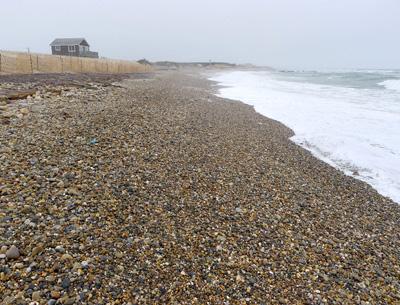At Ditch Plain It's Swim at Your Own Risk

The town beach at Ditch Plain in Montauk will remain closed to swimmers, with no lifeguards on duty, for the foreseeable future. Erosion has stripped away the sand on shore and underwater, leaving dangerous rocks as well as concrete building remnants.
East Hampton Town officials are investigating work on a rock revetment to the east of the beach, the subject of a separate story on this page, which has apparently exceeded that allowed under town and state permits. Members of the East Hampton Town Board questioned Tuesday whether the addition of more rocks along that stretch of the shore has caused the excessive scouring at Ditch.
“I think it’s only exacerbated it,” said Councilman Peter Van Scoyoc. “There is an annual trend” of wintertime sand erosion and springtime accretion in the area, but this year, while Hurricane Sandy began the erosion process in late October, the trend has not reversed.
The rock revetment — which doubled the size of an existing 880-foot structure, according to the executive director of Concerned Citizens of Montauk, Jeremy Samuelson — “had nothing to do” with the extreme erosion at the Ditch beach, Town Supervisor Bill Wilkinson asserted at the board meeting Tuesday.
“It’s a pretty common dynamic,” said Mr. Van Scoyoc, referring to scouring caused to nearby areas by hard structures along the beach.
According to the town’s director of natural resources, Kim Shaw, town records show that Montauk Shores Condominiums applied for a permit in the early 1990s to construct an 880-foot rock revetment and to repair drainage pipes at the top of the dunes. Though the East Hampton Zoning Board of Appeals allowed the drainage-pipe work to proceed, it required an environmental impact statement for the revetment work, to assess its potential effect.
Records do not indicate that was ever done, though rocks were installed, apparently under an “emergency repairs” provision of the town code. In subsequent years, according to Ms. Shaw, the condo association applied for and received building permits to install a combination of sand, filter fabric, and rocks. Pat Gunn, who heads the Division of Public Safety, which includes ordinance enforcement, is investigating, Ms. Shaw said.
“These are exactly the types of structures that impact coastal processes and should be vetted by coastal engineers as well as regulatory agencies,” said Mr. Samuelson of C.C.O.M. on Tuesday. “The applicants in this case have completely misrepresented their intentions.”
Meanwhile, the town board discussed paying to add sand to the Ditch beach so it can be used as a bathing beach this summer. Mr. Wilkinson suggested hiring Drew Bennett, an East Hampton consulting engineer, to assess the feasibility of a “beach-scraping” project, taking built-up sand from the western part of the Ditch beach and moving it onto the areas of exposed rock. State permits would be required for the work.
Mr. Bennett’s areas of expertise, according to his Web site, are architectural engineering and construction, civil engineering, including coastal engineering, and environmental engineering, including various water-related issues.
“It’s problematic to place any sand there until the pattern of erosion changes,” Mr. Van Scoyoc said. The trailer park’s rock revetment is “completely exposed and interacting with the ocean” to unknown effect, he said.
“It’s just a temporary solution to get sand at Ditch,” Mr. Wilkinson said.
“I’d like to understand the dynamic” before committing the funds to move sand onto the beach, said Councilwoman Sylvia Overby.
“This is something that the coastal engineers could look at — somebody with real expertise,” said Mr. Van Scoyoc. With Mr. Stanzione and Ms. Overby, he had resolved several weeks ago, at a meeting where the other two board members were absent, to hire an independent coastal engineer to give the town facts on which to base decisions about erosion, in downtown Montauk and elsewhere.
“We need a coastal engineer to start this work,” Mr. Van Scoyoc repeated. “There seems to be some resistance to moving forward,” he said, after Ms. Quigley and Mr. Wilkinson raised questions.
In light of the board’s discussions of potential changes to the town’s coastal policy, amending the Local Waterfront Revitalization Project plan to allow the installation of temporary hard structures to protect oceanfront buildings threatened by erosion, Mr. Van Scoyoc said he was concerned about “changing the L.W.R.P. in that fashion without a scientific basis.”
“This board needs coverage,” said John Jilnicki, the town attorney. “If you adopt something and you don’t have the expertise to back up your decision, you’re going to have liability.”
“If something happens because we issue a permit,” Mr. Jilnicki said, referring to potential negative effects on neighboring properties if the town allows hard structures to go in on the beach, “there’s no doubt that we would be held responsible.”
With the exception of posting a summer traffic control officer to keep people out of the water, an idea to which Councilwoman Theresa Quigley strenuously objected on the grounds that it would be “interfering with somebody’s free choice to take a swim,” the board agreed to implement suggestions from town lifeguards and John Rooney, the parks and recreation superintendent. “No swimming” signs pointing out the safety hazards will be prominently posted at Ditch. Kirk Park beach, at the western side of downtown Montauk, will be opened earlier than usual, with lifeguards posted there.
Board members also will begin to seek out a coastal engineer, and authorized the town Planning Department to apply for a grant that could help to cover the cost.
